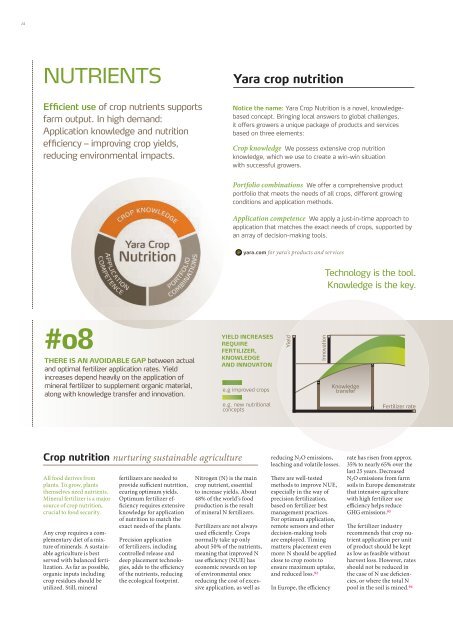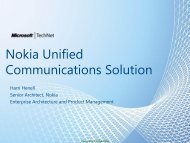Yara crop nutrition
Yara crop nutrition
Yara crop nutrition
Create successful ePaper yourself
Turn your PDF publications into a flip-book with our unique Google optimized e-Paper software.
14<br />
NUTRIENTS<br />
<strong>Yara</strong> <strong>crop</strong> <strong>nutrition</strong><br />
Efficient use of <strong>crop</strong> nutrients supports<br />
farm output. In high demand:<br />
Application knowledge and <strong>nutrition</strong><br />
efficiency – improving <strong>crop</strong> yields,<br />
reducing environmental impacts.<br />
Notice the name: <strong>Yara</strong> Crop Nutrition is a novel, knowledgebased<br />
concept. Bringing local answers to global challenges,<br />
it offers growers a unique package of products and services<br />
based on three elements:<br />
Crop knowledge We possess extensive <strong>crop</strong> <strong>nutrition</strong><br />
knowledge, which we use to create a win-win situation<br />
with successful growers.<br />
Portfolio combinations We offer a comprehensive product<br />
portfolio that meets the needs of all <strong>crop</strong>s, different growing<br />
conditions and application methods.<br />
Application competence We apply a just-in-time approach to<br />
application that matches the exact needs of <strong>crop</strong>s, supported by<br />
an array of decision-making tools.<br />
yara.com for yara’s products and services<br />
Technology is the tool.<br />
Knowledge is the key.<br />
#08<br />
THERE IS AN AVOIDABLE GAP between actual<br />
and optimal fertilizer application rates. Yield<br />
increases depend heavily on the application of<br />
mineral fertilizer to supplement organic material,<br />
along with knowledge transfer and innovation.<br />
YIELD INCREASES<br />
REQUIRE<br />
FERTILIZER,<br />
KNOWLEDGE<br />
AND INNOVATON<br />
Yield<br />
e.g improved e.g improved <strong>crop</strong>s <strong>crop</strong>s<br />
Yield<br />
Innovation<br />
Innovation<br />
Knowledge Knowledge<br />
transfer transfer<br />
e.g. new e.g. new <strong>nutrition</strong>al <strong>nutrition</strong>al<br />
concepts concepts<br />
Fertilizer Fertilizer rate rate<br />
Crop <strong>nutrition</strong> nurturing sustainable agriculture<br />
All food derives from<br />
plants. To grow, plants<br />
themselves need nutrients.<br />
Mineral fertilizer is a major<br />
source of <strong>crop</strong> <strong>nutrition</strong>,<br />
crucial to food security.<br />
Any <strong>crop</strong> requires a complementary<br />
diet of a mixture<br />
of minerals. A sustainable<br />
agri culture is best<br />
served with balanced fertilization.<br />
As far as possible,<br />
organic inputs including<br />
<strong>crop</strong> residues should be<br />
utilized. Still, mineral<br />
fertilizers are needed to<br />
provide sufficient <strong>nutrition</strong>,<br />
ecuring optimum yields.<br />
Optimum fertilizer efficiency<br />
requires extensive<br />
knowledge for application<br />
of <strong>nutrition</strong> to match the<br />
exact needs of the plants.<br />
Precision application<br />
of fertilizers, including<br />
controlled release and<br />
deep placement technologies,<br />
adds to the efficiency<br />
of the nutrients, reducing<br />
the ecological footprint.<br />
Nitrogen (N) is the main<br />
<strong>crop</strong> nutrient, essential<br />
to increase yields. About<br />
48% of the world’s food<br />
production is the result<br />
of mineral N fertilizers.<br />
Fertilizers are not always<br />
used efficiently. Crops<br />
normally take up only<br />
about 50% of the nutrients,<br />
meaning that improved N<br />
use efficiency (NUE) has<br />
economic rewards on top<br />
of environmental ones:<br />
reducing the cost of excessive<br />
application, as well as<br />
reducing N 2 O emissions,<br />
leaching and volatile losses.<br />
There are well-tested<br />
methods to improve NUE,<br />
especially in the way of<br />
precision fertilization,<br />
based on fertilizer best<br />
management practices.<br />
For optimum application,<br />
remote sensors and other<br />
decision-making tools<br />
are employed. Timing<br />
matters; placement even<br />
more: N should be applied<br />
close to <strong>crop</strong> roots to<br />
ensure maximum uptake,<br />
and reduced loss. 92<br />
In Europe, the efficiency<br />
rate has risen from approx.<br />
35% to nearly 65% over the<br />
last 25 years. Decreased<br />
N 2 O emissions from farm<br />
soils in Europe demonstrate<br />
that intensive agriculture<br />
with high fertilizer use<br />
efficiency helps reduce<br />
GHG emissions. 93<br />
The fertilizer industry<br />
recommends that <strong>crop</strong> nutrient<br />
application per unit<br />
of product should be kept<br />
as low as feasible without<br />
harvest loss. However, rates<br />
should not be reduced in<br />
the case of N use deficiencies,<br />
or where the total N<br />
pool in the soil is mined. 94



